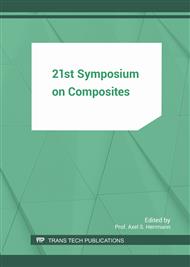p.3
p.9
p.17
p.25
p.31
p.38
p.46
p.54
Ultrasonic-Impregnation for Fiber-Reinforced Thermoplastic Prepreg Production
Abstract:
Fiber-reinforced thermoplastics have a high potential for big scale light weight process applications due to low processing times and recyclability. Further advantages are the low emissions during the manufacturing process and beneficial handling and storing properties of the semi finished materials. Thermoplastic composites are made of reinforcement fibers and a thermoplastic polymer matrix by applying two essential sub processes: (1) melting of the matrix-material and (2) impregnating the textile component with molten matrix-material. At present state of art both sub-processes are applied by using double-belt-presses, characterized by high processing temperatures and high processing forces. Therefore, a large amount of energy is needed to create the necessarily high compaction forces and temperatures with hydraulic cylinders and electric heating. Convection, infrared-radiation and the cooling (dynamic) of tempered machine parts leads to a significant dissipation of energy. Especially the process for generating the hydraulic pressure has a low level of efficiency. Therefore, in respect to economic and ecologic reasons, novel energy-efficient impregnation processes need to be investigated and developed. The represented novel impregnation process is based on ultrasonic technology. A stack of polymer film (outer layers) and a textile ply (inner layer) is formed and the energy is applied with an ultrasonic sonotrode. The efficient, fast and strongly concentrated energy application into the thermoplastic films allows the development of novel and highly flexible machine concepts. These can be used for development of small scale up to large scale production processes. The ultrasonic-technology allows a continuous impregnation of the textile component with molten matrix-material. A custom-designed prototype was developed. First material samples were produced and the technological parameters studied. A characterization of the experimental results, material samples, prototype machine and process is the focus of this paper.
Info:
Periodical:
Pages:
17-24
Citation:
Online since:
July 2017
Price:
Сopyright:
© 2017 Trans Tech Publications Ltd. All Rights Reserved
Share:
Citation:


